1. 类和对象上
1.1 类的定义
1.1.1 类的定义格式

cpp
// 数据和方法封装放到了一起,都在类里面
// 封装的本质体现了更严格的规范管理
class Stack
{
public:
// 成员函数
void Init(int capacity = 4)
{
_a = nullptr; // malloc
_top = 0;
_capacity = capacity;
}
void Push(int x)
{}
private:
// 成员变量
int* _a;
int _top;
int _capacity;
//int capacity_;
////member
//int m_capacity;
//int mCapacity;
};面向对象三大特性:封装,继承,多态
1.1.2 访问限定符

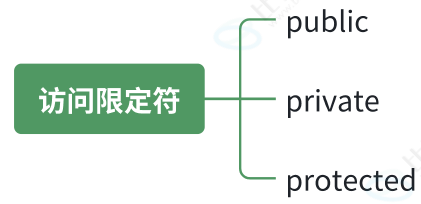
1.1.3 类域
- 类定义了一个新的作用域,类的所有成员都在类的作用域中,在类体外定义成员时,需要使用 :: 作用域操作符指明成员属于哪个类域。
- 类域影响的是编译的查找规则,下面程序中Init如果不指定类域Stack,那么编译器就把Init当成全局函数,那么编译时,找不到array等成员的声明/定义在哪里,就会报错。指定类域Stack,就是知道Init是成员函数,当前域找不到的array等成员,就会到类域中去查找。
1.2 实例化
1.2.1 实例化概念
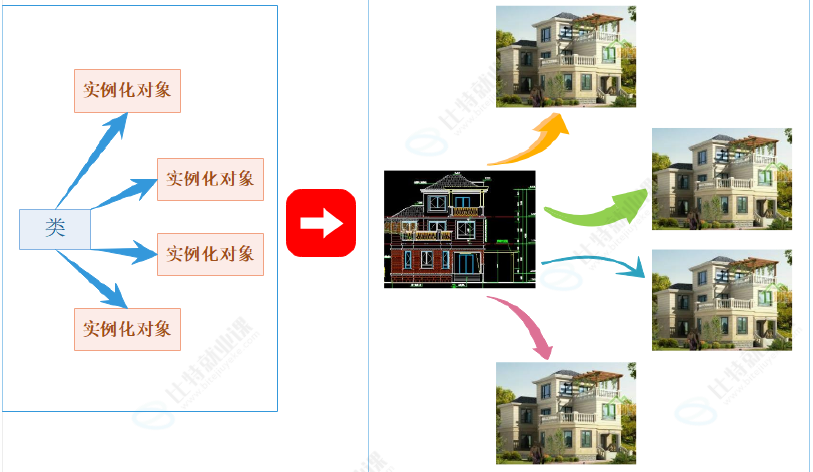
1.2.2 对象大小
类的成员函数,成员函数的指针是不需要存储的,函数指针是一个地址,调用函数被编译成汇编指令【call地址】,其实编译器在编译链接时,就要找到函数的地址,不是在运行时找,只有动态多态是在运行时找,就需要存储函数地址。
类实例化的对象也要符合内存对齐的规则
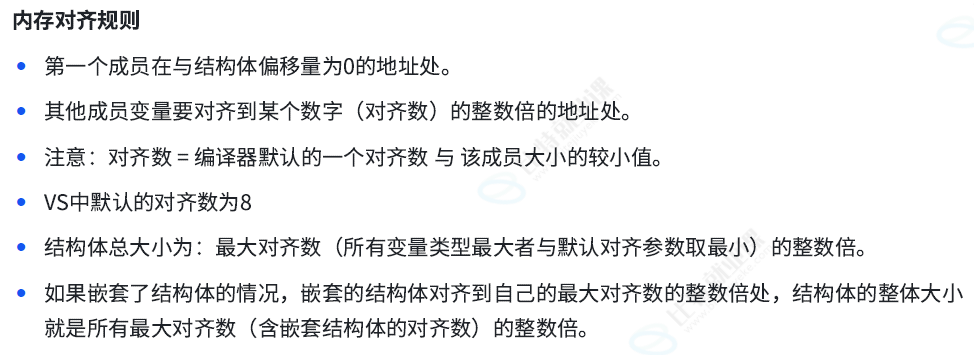
cpp
class Stack
{
public:
// 成员函数
void Init(int n = 4)
{
}
//private:
// 成员变量,声明
int* array; // 4 8 4
size_t capacity; // 8 8
size_t top; // 8 8 8
};
int main()
{
// 定义,类实例化对象
Stack s1;
s1.top = 0;
s1.Init();
Stack s2;
s1.top = 1;
s2.Init(100);
cout << sizeof(s1) << endl; //24
cout << sizeof(Stack) << endl; //24
return 0;
}
cpp
class A
{
public:
void Print()
{
cout << _ch << endl;
}
private:
char _ch;
int _i;
};
class B
{
public:
void Print()
{
//...
}
};
class C
{};
int main()
{
cout << sizeof(A) << endl; //4
// 开1byte为了占位,不存储实际数据,表示对象存在过
cout << sizeof(B) << endl; //1
cout << sizeof(C) << endl; //1
B b1;
B b2;
cout << &b1 << endl; //00000037F8EFF6D4
cout << &b2 << endl; //00000037F8EFF6D4
return 0;
}1.2.3 this指针
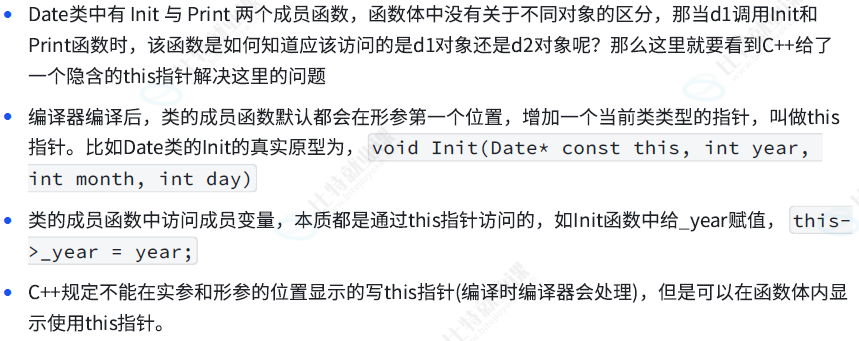
cpp
class Date
{
public:
//void Init(Date* const this, int year, int month, int day)
void Init(int year, int month, int day)
{
cout << this << endl;
//const保护this不能修改
//this = nullptr;
//this->_year = year;
this->_year = year;
this->_month = month;
_day = day;
}
void Print()
{
cout << _year << "/" << _month << "/" << _day << endl;
}
private:
// 这里只是声明,没有开空间
int _year;
int _month;
int _day;
};
int main()
{
Date d1;
Date d2;
// d1.Init(&d1, 2025, 7, 31);
d1.Init(2025, 7, 31);
//d2.Init(&d2, 2025, 7, 31);
d2.Init(2025, 9, 1);
d1.Print();
d2.Print();
return 0;
}2. 类和对象中
2.1 类的默认成员函数
默认成员函数就是用户没有显式实现,编译器会自动生成的成员函数称为默认成员函数。一个类,我们不写的情况下编译器会默认生成以下6个默认成员函数,需要注意的是这6个中最重要的是前4个,最后两个取地址重载不重要,我们稍微了解一下即可。其次就是C++11以后还会增加两个默认成员函数,移动构造和移动赋值,这个我们后面再讲解。默认成员函数很重要,也比较复杂,我们要从两个方面去学习:
- 第一:我们不写时,编译器默认生成的函数行为是什么,是否满足我们的需求。
- 第二:编译器默认生成的函数不满足我们的需求,我们需要自己实现,那么如何自己实现?

2.2 构造函数
构造函数是特殊的成员函数,需要注意的是,构造函数虽然名称叫构造,但是构造函数的主要任务并不是开空间创建对象(我们常使用的局部对象是栈帧创建时,空间就开好了),而是对象实例化时初始化对象。构造函数的本质是要替代我们以前Stack和Date类中写的Init函数的功能,构造函数自动调用的特点就完美的替代的了Init。

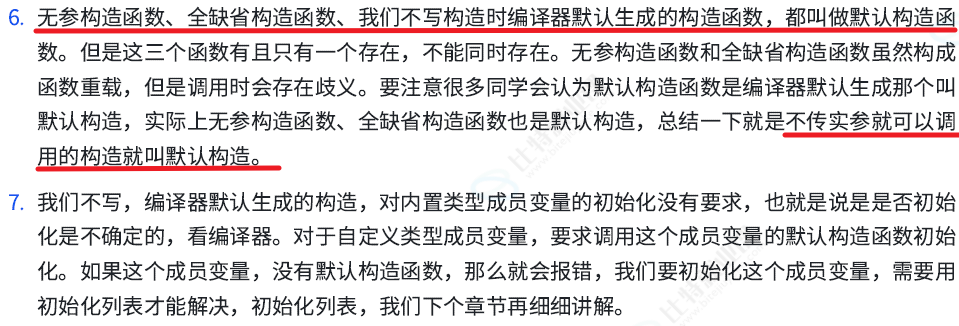
说明:C++把类型分成内置类型(基本类型)和自定义类型。内置类型就是语言提供的原生数据类型,如:int/char/double/指针等,自定义类型就是我们使用class/struct等关键字自己定义的类型。
cpp
class Date
{
public:
//1. 无参构造函数
//Date()
//{
// _year = 2000;
// _month = 1;
// _day = 1;
//}
// 2. 带参构造函数,不是默认构造函数
//Date(int year, int month, int day)
//{
// _year = year;
// _month = month;
// _day = day;
//}
// 3. 全缺省构造函数
Date(int year = 2000, int month = 1, int day = 1)
{
_year = year;
_month = month;
_day = day;
}
void Print()
{
cout << _year << "/" << _month << "/" << _day << endl;
}
private:
int _year;
int _month;
int _day;
};
int main() {
//函数声明
/*Date func();*/
Date d1; //2000/1/1
Date d2 = Date(2025, 9, 9); //2025/9/9
d1.Print();
d2.Print();
}
注意:如果通过无参构造函数创建对象时,对象后面不用跟括号,否则编译器无法区分这里是函数声明还是实例化对象
对于第七点,编译器默认生成的构造,对于内置变量的初始化没有要求:
cpp
class Date {
public:
void Print() {
cout << _year << "/" << _month << "/" << _day;
}
private:
//内置类型
int _year;
int _month;
int _day;
};
int main() {
Date d1;
d1.Print();
return 0;
}
对于自定义类型的成员变量,要求调用这个自定义成员变量的默认构造函数,如果这个自定义成员变量没有默认构造函数,则会报错,否则用初始化列表解决(后续讲到)
自定义成员变量有默认构造函数:
cpp
class Stack {
public:
Stack()
{
_a = nullptr;
_top = 0;
_capacity = 0;
}
private:
int* _a;
int _top;
int _capacity;
};
// 两个栈实现一个队列
class MyQueue
{
private:
// 自定义类型
Stack _pushst;
Stack _popst;
};
int main() {
MyQueue q;
return 0;
}如果自定义类型没有默认构造函数,则会报错:
cpp
class Date {
public:
void Print() {
cout << _year << "/" << _month << "/" << _day;
}
private:
//内置类型
int _year;
int _month;
int _day;
};
class Stack {
public:
Stack(int n)
{
_a = nullptr;
_top = 0;
_capacity = 0;
}
private:
int* _a;
int _top;
int _capacity;
};
// 两个栈实现一个队列
class MyQueue
{
private:
// 自定义类型
Stack _pushst;
Stack _popst;
};
int main() {
Date d1;
d1.Print();
MyQueue q;
return 0;
}
自定义成员的默认构造函数中如果有内置类型:
cpp
class Date {
public:
void Print() {
cout << _year << "/" << _month << "/" << _day;
}
private:
//内置类型
int _year;
int _month;
int _day;
};
class Stack {
public:
Stack()
{
_a = nullptr;
_top = 0;
_capacity = 0;
}
private:
int* _a;
int _top;
int _capacity;
};
// 两个栈实现一个队列
class MyQueue
{
private:
// 自定义类型
Stack _pushst;
Stack _popst;
int _size;
};
int main() {
Date d1;
d1.Print();
MyQueue q;
return 0;
}内置函数初始化的变量:

2.3 析构函数
析构函数与构造函数功能相反,析构函数不是完成对对象本身的销毁,比如局部对象是存在栈帧的,函数结束栈帧销毁,他就释放了,不需要我们管,C++规定对象在销毁时会自动调用析构函数,完成对象中资源的清理释放工作。析构函数的功能类比我们之前Stack实现的Destroy功能,而像Date没有Destroy,其实就是没有资源需要释放,所以严格说Date是不需要析构函数的。
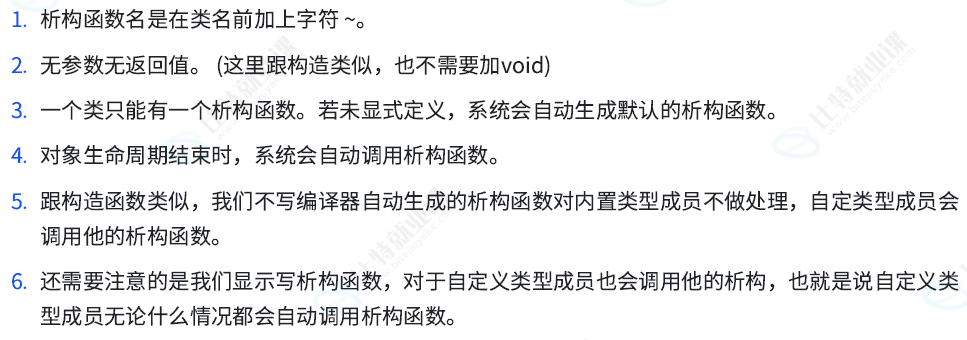

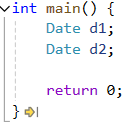

后定义的先析构
cpp
//析构函数
class Date {
public:
Date(int year=2000, int month=1, int day=1) {
_year = year;
_month = month;
_day = day;
}
void Print() {
cout << _year << "/" << _month << "/" << _day << endl;
}
//日期类的析构函数可以不写,因为没有资源释放的需求
~Date()
{
cout << "~Date()" << _day;
}
private:
//内置类型
int _year;
int _month;
int _day;
};
class Stack {
public:
Stack()
{
_a = nullptr;
_top = 0;
_capacity = 0;
}
private:
int* _a;
int _top;
int _capacity;
};
int main() {
Date d1;
Date d2;
return 0;
}对于第五点:
cpp
//析构函数
class Date {
public:
Date(int year=2000, int month=1, int day=1) {
_year = year;
_month = month;
_day = day;
}
void Print() {
cout << _year << "/" << _month << "/" << _day << endl;
}
//日期类的析构函数可以不写,因为没有资源释放的需求
~Date()
{
cout << "~Date()" << _day;
}
private:
//内置类型
int _year;
int _month;
int _day;
};
class Stack {
public:
Stack(int n = 4)
{
_a = (int*)malloc(sizeof(int)*n);
//检查a是否开辟成功
_top = 0;
_capacity = n;
}
// 有资源申请,自己写析构
~Stack() {
if (_a)
{
cout << "~Stack()" << endl;
free(_a);
_a = nullptr;
_top = 0;
_capacity = 0;
}
}
private:
int* _a;
int _top;
int _capacity;
};
// 两个栈实现一个队列
class MyQueue
{
private:
// 自定义类型
Stack _pushst;
Stack _popst;
int _size;
};
int main() {
Date d1;
Date d2;
Stack s1;
Stack s2(10);
MyQueue q;
return 0;
}
对于第六点,对于自定义类型成员,显示写析构和不显示写析构,默认生成都会去调用自定义类型成员的析构,就是为了保证资源不会泄露


对于括号匹配问题,C和C++的区别

2.4 拷贝构造
如果一个构造函数的第一个参数是自身类类型的引用,且任何额外的参数都有默认值,则此构造函数也叫做拷贝构造函数,也就是说拷贝构造是一个特殊的构造函数。
拷贝构造的特点:
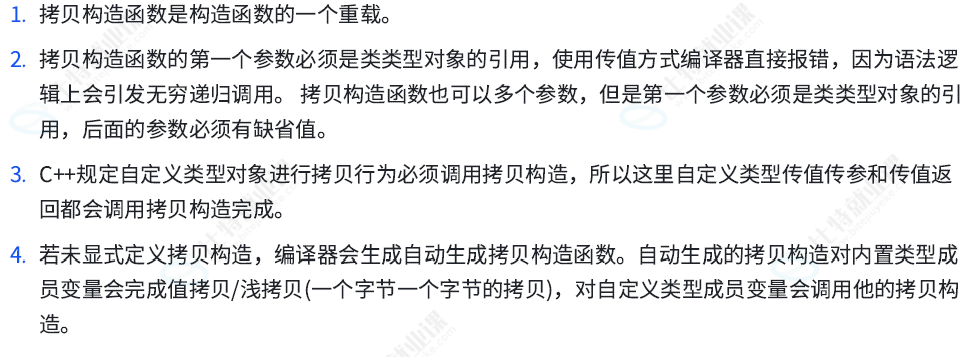
cpp
class Date
{
public:
Date(int year = 1, int month = 1, int day = 1)
{
_year = year;
_month = month;
_day = day;
}
Date(Date& d)
{
_year = d._year;
_month = d._month;
_day = d._day;
}
void Print()
{
cout << _year << "-" << _month << "-" << _day << endl;
}
private:
int _year;
int _month;
int _day;
};
// 自定义类型传值传参要调用拷贝构造
void Func(Date d)
{
}
//void Func(Date& d)
//{
//
//}
int main()
{
Date d1(2025, 8, 1);
// 拷贝构造,拷贝同类型的对象完成初始化
Date d2(d1);
Func(d1);
}传值传参需要调用拷贝构造
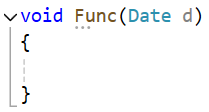
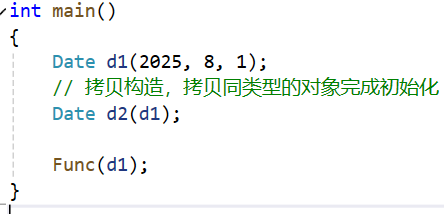
这个Func(d1),d1传给Func里的d,需要先调用拷贝构造,再进去Func函数(先完成传参这个动作)
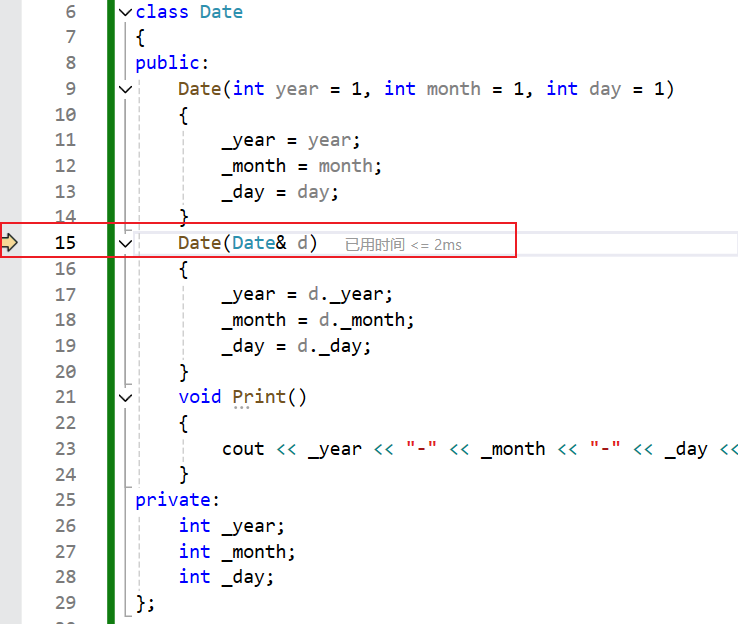
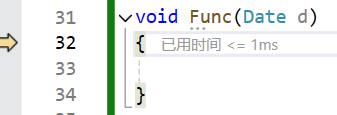
如果是引用传参,就不需要调用拷贝构造,直接进来就调用函数

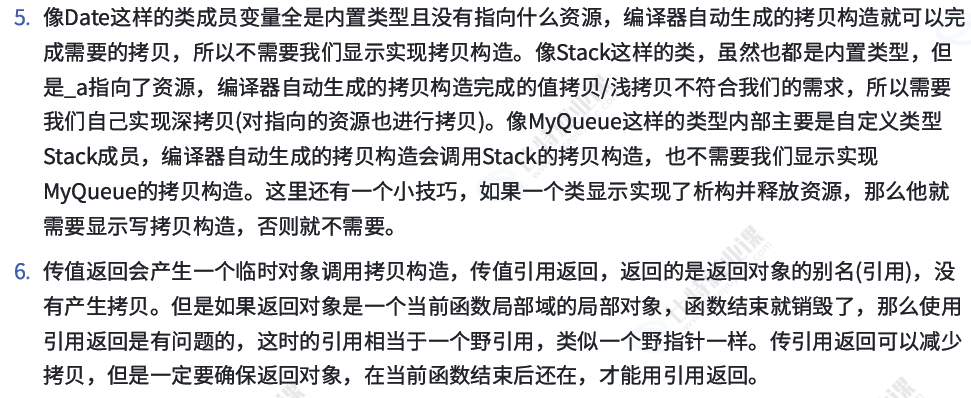
如果拷贝构造是传值传参,则会出现无穷递归的情况
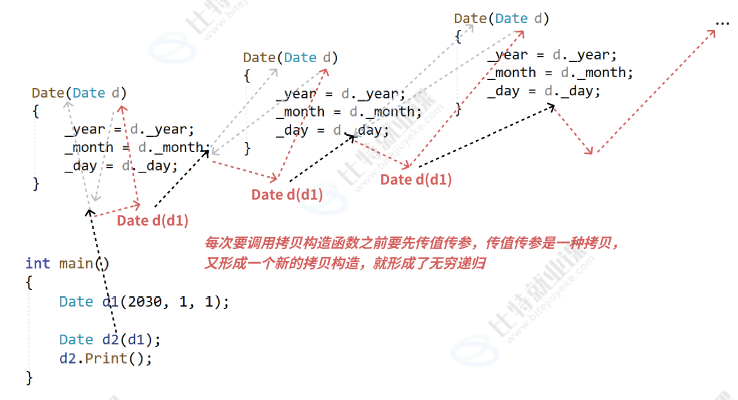
如果使用引用传参,就不会出现这个问题,建议引用传参都要加const,加const方便传参,权限可以平移,也可以缩小,但不能放大
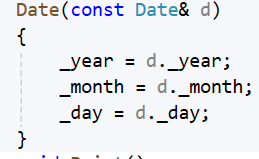

如果不加,就会出现权限放大的问题:
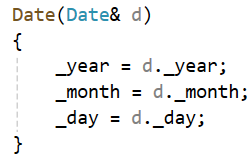


栈Stack的拷贝构造(出错情况):
cpp
typedef int STDataType;
class Stack
{
public:
Stack(int n = 4)
{
_a = (STDataType*)malloc(sizeof(STDataType) * n);
if (nullptr == _a)
{
perror("malloc申请空间失败");
return;
}
_capacity = n;
_top = 0;
}
// Stack st2(st1);
//Stack(const Stack& s)
//{
// _a = s._a;
// _capacity = s._capacity;
// _top = s._top;
//}
Stack(const Stack& s)
{
_a = (STDataType*)malloc(sizeof(STDataType) * s._capacity);
if (_a == NULL)
{
perror("realloc fail");
return;
}
memcpy(_a, s._a, s._top * sizeof(STDataType));
_capacity = s._capacity;
_top = s._top;
}
void Push(STDataType x)
{
if (_top == _capacity)
{
int newcapacity = _capacity * 2;
STDataType* tmp = (STDataType*)realloc(_a, newcapacity *
sizeof(STDataType));
if (tmp == NULL)
{
perror("realloc fail");
return;
}
_a = tmp;
_capacity = newcapacity;
}
_a[_top++] = x;
}
~Stack()
{
cout << "~Stack()" << endl;
free(_a);
_a = nullptr;
_top = _capacity = 0;
}
private:
STDataType* _a;
size_t _capacity;
size_t _top;
};
class MyQueue
{
private:
Stack _pushst;
Stack _popst;
};
void Func( const Date& d)
{
}
// 自定义类型传值传参要调用拷贝构造
//void Func(Date d)
//{
//
//}
int main()
{
Date d1(2025, 8, 1);
// 拷贝构造,拷贝同类型的对象完成初始化
Date d2(d1);
Func(d1);
const Date d3(2025, 8, 1);
Date d4(d3);
Stack st1;
st1.Push(1);
st1.Push(2);
st1.Push(3);
Stack st2(st1);
MyQueue q1;
MyQueue q2(q1);
}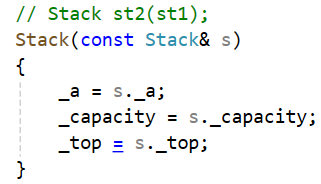
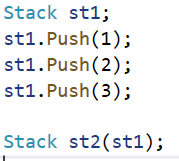
发生如下报错(程序出现内存相关的问题):
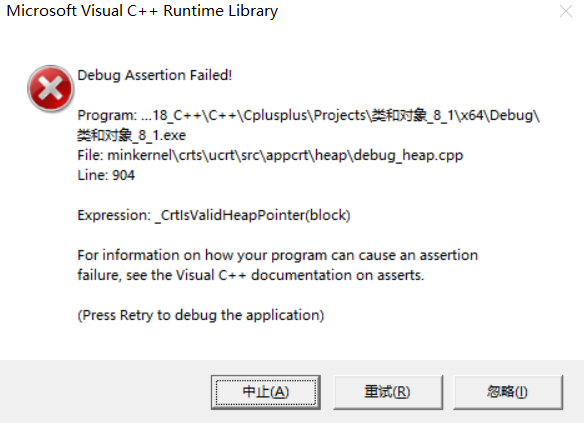

出了作用域调析构

第二次free挂了
 上面的情况是浅拷贝/值拷贝,只把对象的值拷贝过去,一个对象的修改会影响另一个对象,浅拷贝的时候, 指向的是同一块空间
上面的情况是浅拷贝/值拷贝,只把对象的值拷贝过去,一个对象的修改会影响另一个对象,浅拷贝的时候, 指向的是同一块空间
如果是内置类型,可以用浅拷贝,但如果是自定义的类型,尤其是有指向的资源,就得用深拷贝,深拷贝指向的是不同的空间
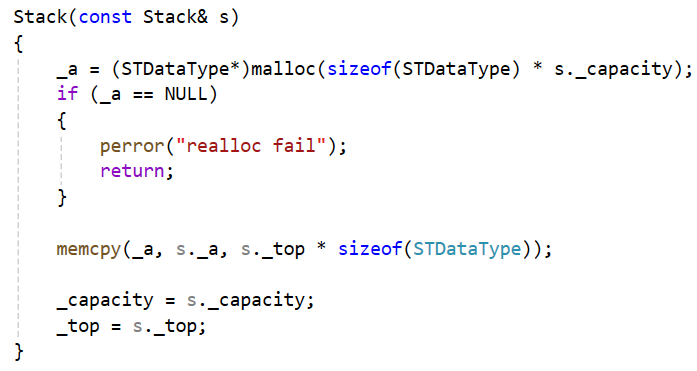

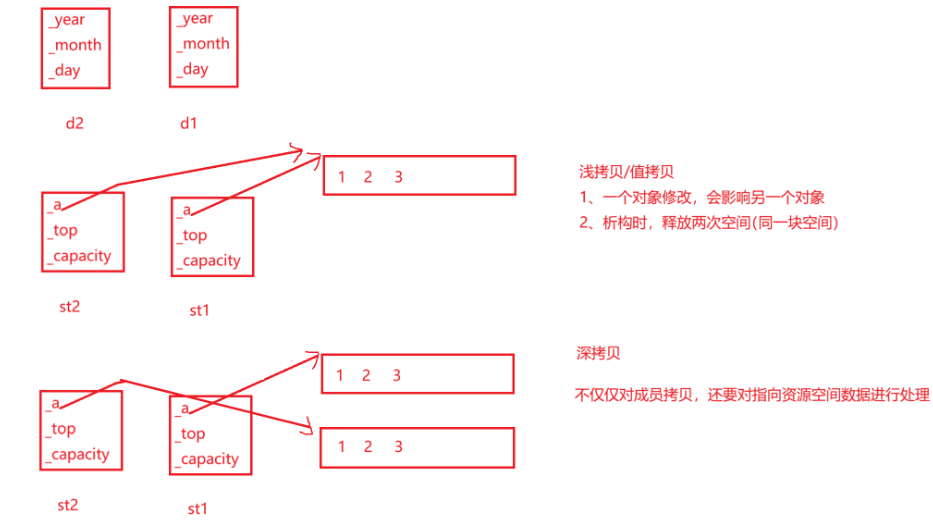
对于第四点,Date类可以调用默认的拷贝构造,因为都是内置类型,但是Stack必须自己写一个拷贝构造,原因如上,MyQueue类也可以调用默认的拷贝构造,因为对自定义类型成员变量会调用他的拷贝构造,也就是说会调用Stack的拷贝构造。一个类的析构和拷贝构造通常是绑定在一起的


栈的传引用返回(会出现野指针的现象):
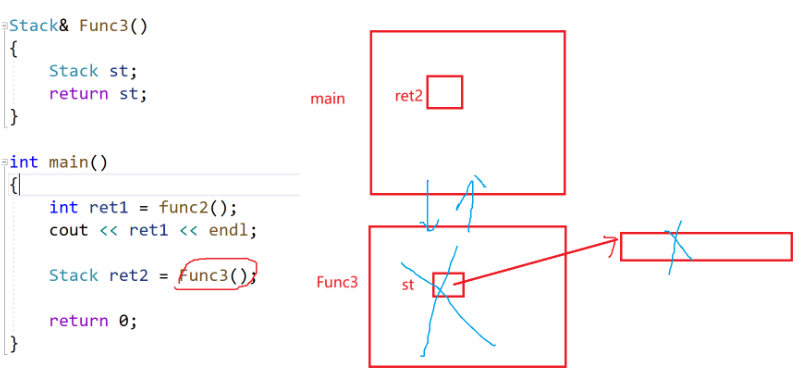
如果是传值返回,会调用拷贝构造
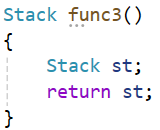
以下两种形式都是拷贝构造

第二行这样写就有点怪

2.5 赋值运算符重载
2.5.1 运算符重载

如果运算符重载函数在类外,而类内的成员变量为private修饰,那么成员变量就会不可访问,所以一般运算符重载函数写在类内
cpp
class Date
{
public:
Date(int year = 1, int month = 1, int day = 1)
{
_year = year;
_month = month;
_day = day;
}
void Print()
{
cout << _year << "-" << _month << "-" << _day << endl;
}
//其实还有个形参this
bool operator==(const Date& d)
{
return _year == d._year
&& _month == d._month
&& _day == d._day;
}
private:
int _year;
int _month;
int _day;
};
int main()
{
Date d1(2025, 8, 1);
Date d2(2025, 10, 1);
cout << (d1 == d2) << endl;
d1.operator==(d2);
return 0;
}成员函数的指针要指明域
cpp
void func1()
{
cout << "void func()" << endl;
}
class A
{
public:
void func2()
{
cout << "A::func()" << endl;
}
};
int main()
{
// 普通函数指针
void(*pf1)() = func1;
(*pf1)();
// A类型成员函数的指针
void(A::*pf2)() = &A::func2;
A aa;
(aa.*pf2)();
return 0;
}
cpp
void(A::*pf2)() = &A::func2;A前面加&相当于是一种C++规定


2.5.2 赋值运算符重载
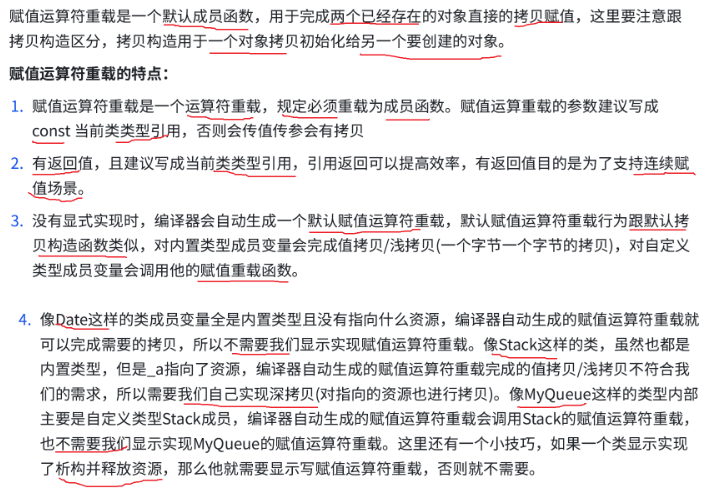
拷贝构造和赋值运算符重载的区别:
请牢牢记住赋值重载完成两个已经存在的对象直接的拷贝赋值
而拷贝构造用于一个对象拷贝初始化给另一个要创建的对象
cpp
class Date
{
public:
Date(int year = 1, int month = 1, int day = 1)
{
_year = year;
_month = month;
_day = day;
}
// Date d4(d3);
Date(const Date& d)
{
_year = d._year;
_month = d._month;
_day = d._day;
}
// d1 = d3 = d5
// d1 = d1
Date& operator=(const Date& d)
{
if (this != &d)
{
_year = d._year;
_month = d._month;
_day = d._day;
}
return *this;
}
void Print()
{
cout << _year << "-" << _month << "-" << _day << endl;
}
private:
int _year;
int _month;
int _day;
};
int main()
{
Date d1(2025, 8, 1);
Date d2(d1);
// 一定注意,这个是拷贝构造
Date d4 = d1;
Date d3(2025, 10, 1);
d1 = d3;
Date d5(2025, 9, 1);
d1 = d3 = d5;
d1 = d1;
return 0;
}2.6 日期类的实现
要实现日期类的加减法,加法思路如下,向月份进位(30/31天,二月份另算),减法思路类似,向月份借位(30/31天,二月份另算)
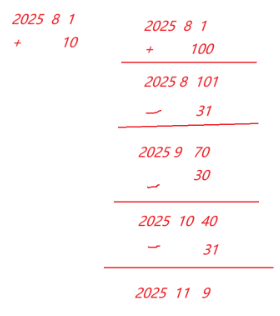
拷贝次数如下图所示:
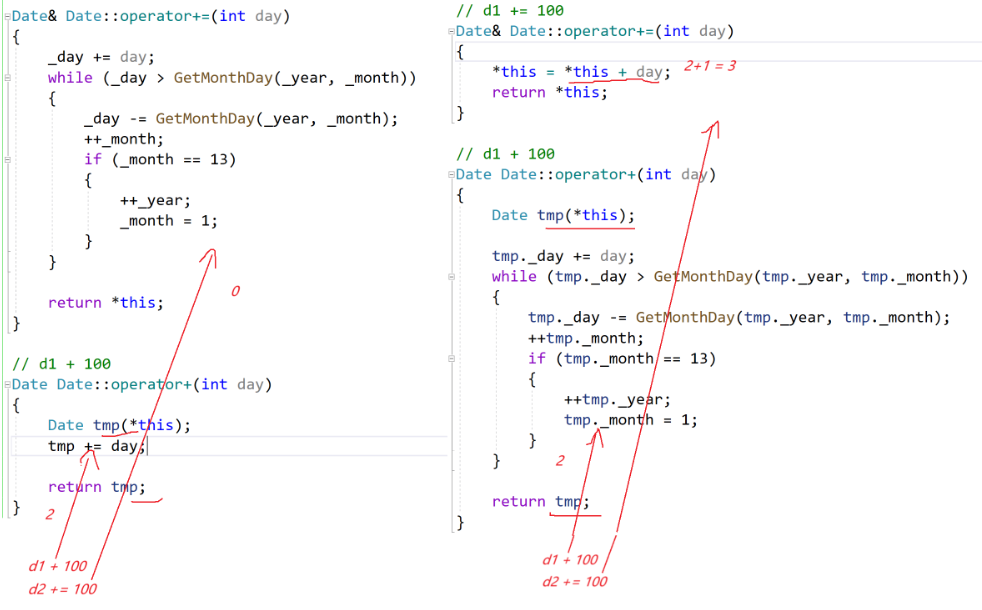
代码:
Date.h
cpp
#pragma once
#include<iostream>
#include<assert.h>
using namespace std;
class Date
{
public:
//全缺省参数在只函数声明或者函数定义
Date(int year = 2000, int month = 1, int day = 1);
void Print();
int GetMonthDay(int year, int month)
{
assert(month > 0 && month < 13);
int MonthDayArray[13] = { -1, 31, 28, 31, 30, 31, 30, 31, 31, 30, 31, 30, 31 };
if (month == 2 && (year % 4 == 0 && year % 100 != 0) || (year % 400 == 0))
{
return 29;
}
else
{
return MonthDayArray[month];
}
}
bool operator<(const Date& d);
bool operator<=(const Date& d);
bool operator>(const Date& d);
bool operator>=(const Date& d);
bool operator==(const Date& d);
bool operator!=(const Date& d);
// d1 += 天数
Date& operator+=(int day);
Date operator+(int day);
// d1 -= 天数
Date& operator-=(int day);
Date operator-(int day);
// d1 - d2
int operator-(const Date& d);
// ++d1 -> d1.operator++()
Date& operator++();
// d1++ -> d1.operator++(0)
// 为了区分,构成重载,给后置++,强行增加了一个int形参
// 这里不需要写形参名,因为接收值是多少不重要,也不需要用
// 这个参数仅仅是为了跟前置++构成重载区分
Date operator++(int);
Date& operator--();
Date operator--(int);
private:
int _year;
int _month;
int _day;
};Date.cpp
cpp
#define _CRT_SECURE_NO_WARNINGS 1
#include"Date.h"
Date::Date(int year, int month, int day)
{
_year = year;
_month = month;
_day = day;
};
void Date::Print()
{
cout << _year << "-" << _month << "-" << _day << endl;
}
//原始写法,完整的
// d1 += 100
//Date& Date::operator+=(int day)
//{
// _day += day;
// while (_day > GetMonthDay(_year, _month))
// {
// _day -= GetMonthDay(_year, _month);
// ++_month;
// if (_month == 13) {
// ++_year;
// _month = 1;
// }
// }
// return *this;
//}
//
//// d1+100
//Date& Date::operator+(int day)
//{
// Date& tmp(*this);
//
// tmp._day += day;
//
// while (tmp._day > GetMonthDay(tmp._year, tmp._month))
// {
// tmp._day -= GetMonthDay(tmp._year, tmp._month);
// ++tmp._month;
// if (tmp._month == 13) {
// ++tmp._year;
// tmp._month = 1;
// }
// }
// return tmp;
//
//}
//另外一种写法一
Date& Date::operator+=(int day)
{
_day += day;
while (_day > GetMonthDay(_year, _month))
{
_day -= GetMonthDay(_year, _month);
++_month;
if (_month == 13)
{
++_year;
_month = 1;
}
}
return *this;
}
// d1 + 100
Date Date::operator+(int day)
{
Date tmp(*this);
tmp += day;
return tmp;
}
//// 另一种写法二
//// d1 += 100
//Date& Date::operator+=(int day)
//{
// *this = *this + day;
// return *this;
//}
//
//Date& Date::operator+(int day)
//{
// Date& tmp(*this);
// tmp._day += day;
// while (tmp._day > GetMonthDay(tmp._year, tmp._month))
// {
// tmp._day -= GetMonthDay(tmp._year, tmp._month);
// ++tmp._month;
// if (tmp._month == 13) {
// ++tmp._year;
// tmp._month = 1;
// }
// }
// return tmp;
//}
// 前置++ 和后置++
// 前置++
Date& Date::operator++()
{
*this += 1;
return *this;
}
// 后置++, 为了和前置++进行区分达到重载,形参中添加int, 但这个int不起作用
Date Date::operator++(int)
{
Date tmp(*this);
*this += 1;
return tmp;
}
// 日期类的减法
Date& Date::operator-=(int day)
{
//if (day < 0) //减法变加法
//{
// return *this += _day;
//}
_day -= day;
while (_day <= 0)
{
--_month;
_day += GetMonthDay(_year, _month); //借上个月的天数
if (_month == 0) {
--_year;
_month = 12;
}
}
return *this;
}
Date Date::operator-(int day)
{
Date tmp(*this);
tmp -= day;
return tmp;
}Test.cpp
cpp
///////////////////////////////////////////////////////
// 日期类的实现
#include"Date.h"
int main()
{
// 日期加法
//Date d1(2025, 8, 1);
//Date d2 = d1 += 100;
//d1.Print(); //2025-11-9
//d2.Print(); //2025-11-9
//Date d3(2025, 8, 1);
//Date d4 = d3 + 100;
//d3.Print(); //2025-8-1
//d4.Print(); //2025-11-9
//前置++和后置++
//Date d1(2025, 8, 1);
////Date ret1 = d1.operator++(10); // 显示调用,实参只要是整形就可以
//Date ret1 = d1++;
//ret1.Print(); //2025-8-1
//d1.Print(); //2025-8-2
//
//Date d2(2025, 8, 1);
//Date ret2 = ++d2;
////Date ret2 = d2.operator++();
//ret2.Print(); //2025-8-2
//d2.Print(); //2025-8-2
// 日期类的减法
Date d1(2025, 11, 9);
Date d2 = d1 -= 100;
d1.Print(); //2025 - 8 - 1
d2.Print(); //2025 - 8 - 1
Date d3(2025, 11, 9);
Date d4 = d3 - 100;
d3.Print(); //2025-11-9
d4.Print(); //2025 - 8 - 1
return 0;
}